 Shock absorbers play a very major part in ensuring the safety of a vehicle's driver and passengers while making sure that they enjoy a comfortable ride.
Shock absorbers play a very major part in ensuring the safety of a vehicle's driver and passengers while making sure that they enjoy a comfortable ride.
In the early days of motoring, a vehicle's suspension system was almost non-existent, and on the rough and largely unpaved roads of these times, travelling any distance in a car was not for the faint-hearted.
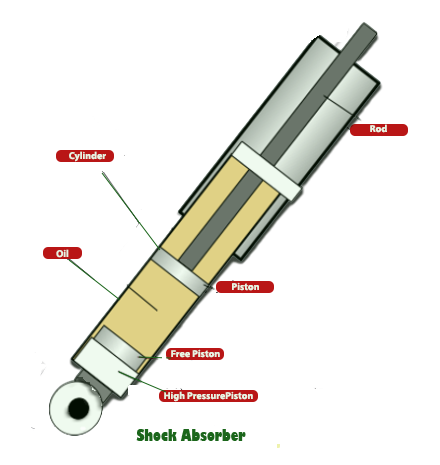 Gradually suspension systems became more advanced, later receiving a significant boost when the early shock absorbers began to make an appearance.
Gradually suspension systems became more advanced, later receiving a significant boost when the early shock absorbers began to make an appearance.
The role of the shock absorber is twofold. The first function, as well as being the best known, is to govern movement between the vehicle's spring and suspension, ensuring that its tyres are more or less in constant contact with the road surface.
The energy removed from the car through vibration is converted by the shock absorbers.
With motoring still in its infancy, developments in shock absorbers and suspension systems went hand in hand, with the best of designers and developers gritting their teeth over four decades till they came up with the best possible solution,
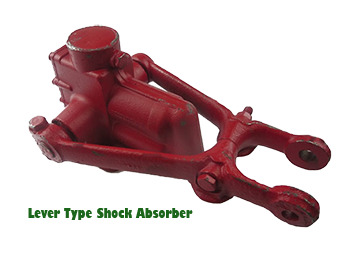 After a number of developments that failed to produce the desire results, during the immediate post-war years, lever-type shock absorbers began to pop up and rapidly took the lion's share of the market.
After a number of developments that failed to produce the desire results, during the immediate post-war years, lever-type shock absorbers began to pop up and rapidly took the lion's share of the market.
Lever-type shock absorbers were fitted in most mass-produced cars during the Fifties and Sixties until they were eventually replaced by telescopic shock absorbers in the Seventies that still lead the market today.
![]()
It stands to reason that vehicles that are seventy to fifty years old have spent at least half of that time traversing the roads of Great Britain and Western Europe that were not always in the best of condition.
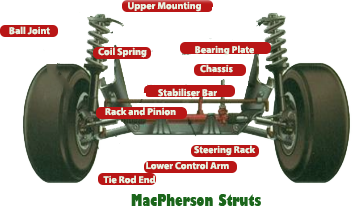 Most motoring experts will strongly suggest that shock absorbers be exchanged on an average of 30,000 miles or four years. Beyond that stage, research and experience show that they gradually wear out, with the driver and passengers enjoying a less comfortable ride.
Most motoring experts will strongly suggest that shock absorbers be exchanged on an average of 30,000 miles or four years. Beyond that stage, research and experience show that they gradually wear out, with the driver and passengers enjoying a less comfortable ride.
Add to that the increasing possibility of the car hitting one bump too many and the driver losing control of the steering, sometimes with disastrous consequences.
Where less-experienced restorers might be caught out when preparing a budget is that the nature of wear and tear is not so apparent. The reason is that any deterioration in their performance will be initially confined to the internal parts and could take a very long time to show its face.
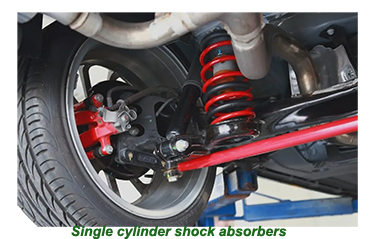 Tell tale signs that the shock absorbers are not performing well can be evidenced by the vehicle's tires are beginning to "feather" – always an indicator that the shock absorbers are starting to wear.
Tell tale signs that the shock absorbers are not performing well can be evidenced by the vehicle's tires are beginning to "feather" – always an indicator that the shock absorbers are starting to wear.
Feathering describes areas of concentrated wear, evenly spaced on the thread, occurring because the tire is bouncing off the road surface instead of remaining flat.
A simple and therefore commonly used method to gauge the extent of shock absorber wear is to push down hard on each corner of the vehicle when it is parked. If the shock absorbers are functioning correctly, the vehicle will immediately bounce back. If the shocks are worn, the vehicle will continue to "bounce" for quite a bit longer.
That means that unless the target vehicle goes through its road test with flying colours, the prospect of renewing its shock absorbers is almost inevitable.
![]()
Even if they are in relatively good condition, most experienced restorers will do away with telescopic absorbers and replacing them with something more fitting to the 21st century.
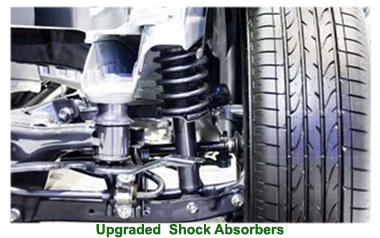 Based on the double action concept, today's shock absorbers generate damping force when the piston is both extending and compressing inside a telescopic cylinder.
Based on the double action concept, today's shock absorbers generate damping force when the piston is both extending and compressing inside a telescopic cylinder.
The maximum resistance force that the shock absorber can call upon uses to suppress the movement of the spring must be predetermined. If the piston is set too taut or too loose, it will adversely affect the vehicle's handling.
 Depending on the vehicle's weight and dimensions, telescopic shock absorbers can be specified with two options- either the "single cylinder "or the "double cylinder ".
Depending on the vehicle's weight and dimensions, telescopic shock absorbers can be specified with two options- either the "single cylinder "or the "double cylinder ".
 Single cylinder shock absorbers are usually fitted on compact cars or lightweight touring cars or coupes. Simple, inexpensive, straightforward to tune and providing first-class heat dissipation single-cylinder shock absorbers are guaranteed to deal with most on and off-road challenges as long as the restorer makes extra sure that single cylinder exactly suits the minimum standards set by the manufacturers.
Single cylinder shock absorbers are usually fitted on compact cars or lightweight touring cars or coupes. Simple, inexpensive, straightforward to tune and providing first-class heat dissipation single-cylinder shock absorbers are guaranteed to deal with most on and off-road challenges as long as the restorer makes extra sure that single cylinder exactly suits the minimum standards set by the manufacturers.
Double-cylinder shock absorbers is the variation most widely found in mid to large-sized family saloons and estates. Providing the highest comfort levels and compatibility with any type of suspension double-cylinder shocks will provide a comfortable ride under most road conditions.
Take me back to the home page.
ub5


